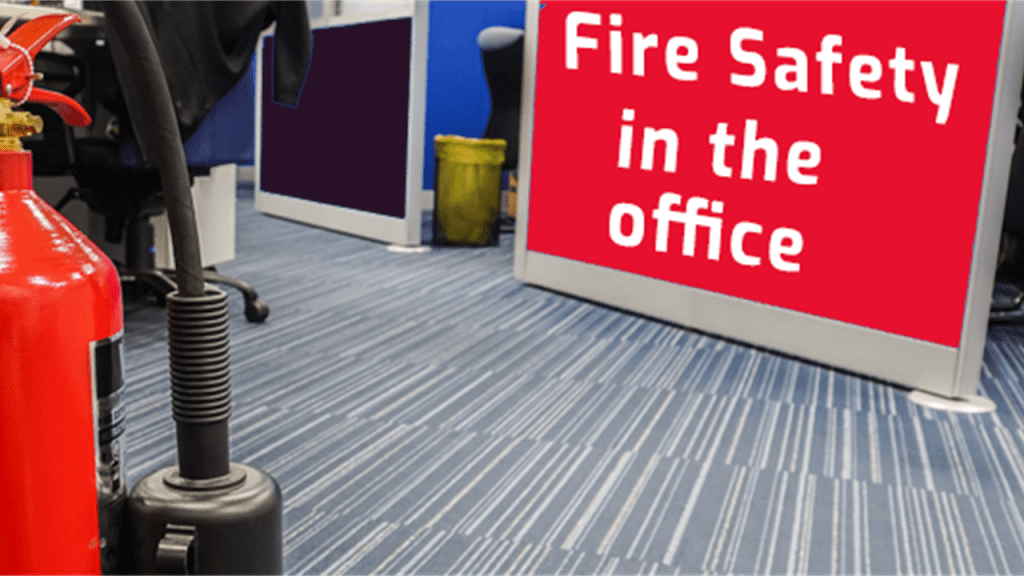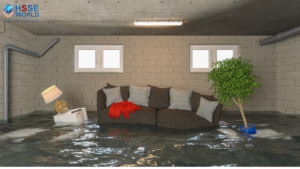Fire safety for office workers
10 min readWhile office workers often don’t think much about the potential for fire while performing their jobs, there are more than 1,000 fires in office environments each year. Such factors as employee complacency; office equipment and appliances that generate heat; and large amounts of paper and other combustible materials can all contribute to office fires resulting in major property damage, serious injuries, and fatalities. This article discusses how to eliminate the factors that contribute to the ignition of fires and how to respond if a fire were to break out.
- Why good housekeeping is important in preventing office fires.
- How to control electrical hazards that can ignite fires.
- What employees should know as part of the company’s Emergency Action Plan.
- How to safely evacuate an area during a fire emergency.
- What the five classes of fire are and what extinguishing agents are used to putting them out.
- How to decide when to use a fire extinguisher to put out a fire; and how to use it properly utilizing the PASS method.
- What to do if someone suffers a fire-related injury.

Fires in the workplace when we hear about these types of incidents, we most often think of fires that break out in facilities such as paper mills, chemical processing operations, and other heavy industrial locations.
Due to the hazardous and flammable materials often used or stored at these facilities and their proximity to employees, these fires can have disastrous consequences, but industrial facilities aren’t the only worksites vulnerable to fire hazards.
While office workers often don’t think much about the potential for fire while performing their jobs, there are more than 1,000 fires in office environments each year.
Such factors as employee complacency, office equipment, and appliances that generate heat and large amounts of paper and other combustible materials can all contribute to office fires resulting in major property damage, serious injuries, and fatalities.
Three elements of fire
All fires require three elements: fuel, heat, and oxygen. Removing any of these three elements will cause the fire to go out.
A fire starts with heat, which can be generated by a wide variety of things in an office environment.
After a fire has been ignited, more heat will produce and it will grow larger as long as there is sufficient fuel and oxygen present.
Materials in an office that can fuel a fire include various products made from paper, cardboard, or wood as well as furnishings such as desks, chairs, or drapes. Various types of office equipment housed in plastic and polymers may also fuel a fire such as printers, copiers, and shredders.
The third requirement for fire is oxygen. The more oxygen available, the more fuel will burn. A fire will use increasing amounts of oxygen from the immediate area as it continues to grow and consume more fuel.
One of three things must happen for a fire to go out: its heat is removed, all the fuel is burned up or its oxygen supply runs out.
When a fire is extinguished, it is usually accomplished by removing either the heat source or the oxygen.
To prevent fires, you must take the necessary precautions to keep fuels from coming in contact with any type of heat or ignition source.
Good housekeeping
One of the most effective ways to keep fuels separated from ignition sources is to follow good housekeeping practices.
Keep your work area as neat as possible. Don’t allow the excess paper to stack up and always keep papers separated from any sources of heat that could ignite them.
Don’t allow waste paper and other debris to accumulate on the floor or behind your desk.
Since office trash usually contains a great deal of paper and other combustible products, trash cans should be emptied often and the contents removed from the building and disposed of in an approved waste container.
Controlling electrical hazards in the office
Besides good housekeeping, recognizing and correcting fire hazards is a big part of preventing office fires.
The majority of office fires involve electricity, so you must be aware of any problems with electrical equipment and outlets and be on the lookout for overheating equipment and overloaded circuits.
Be aware that using an excessive number of power cords in the same outlet can overload the circuit and cause a fire.
Equipment that draws a lot of current such as copiers or coffee makers should be plugged directly into an outlet, rather than using an extension cord.
Extension cords should not be used to permanently power equipment because their condition can deteriorate over time. Extension cords are only designed for temporary use and should be removed as soon as possible.
You should inspect power cords periodically to make sure they have not developed cracks in the insulation, have any exposed wires or are missing the grounding pin. Equipment with damaged cords must be removed from service until it can be repaired or replaced.
If you smell something burning or see smoke coming from equipment, unplug it immediately and notify the proper authority.
Toaster ovens, hot plates, coffee makers, and other small appliances should be restricted to the facility’s kitchen or break room. These types of appliances can easily ignite paper and other combustible materials around them.
Check your work area for fire hazards before leaving each day. Straighten up your work area, properly store papers and other combustibles in a safe place away from heat sources and unplug any electrical equipment, not in use.
Becoming familiar with the emergency action plan
Even if you do take all the precautions we have just discussed, the potential for a fire in an office setting still exists. Knowing what to do and what not to do can often mean the difference between life and death. ( Download Infographic fire-emergency/)
Most companies have an emergency action plan that details everyone’s responsibilities in the event of a fire or other emergency. You should become familiar with the plan and know what to do if a fire breaks out.
Your company has a plan in place that outlines what you should do in the event of a fire or other emergency. This plan will detail procedures for reporting fires, fighting fires, and evacuating the premises.
As part of this plan, you should learn the locations of the fire alarms in your work area, how to activate them and what their signal sounds like.
You should know at least two escape routes. This ensures that if one escape route is blocked by fire, you will know another path to safety.
It is critical that you know how to get from your workstation to the nearest exit, even with your eyes closed! In the event of a fire, excess smoke or a power failure may require you to escape in the dark.
You must also know the designated meeting place where you are to report after evacuating. This allows all employees to be accounted for so emergency workers can promptly search for the missing.
Some large buildings may have more than one meeting place, while some tall structures have meeting places within the building depending on the location of the fire. The important thing is to be familiar with your organization’s emergency action plan and knows where to go in the event of a fire.( learn more: fire-emergency-evacuation-plan-and-the-fire-procedure/).
Evacuation procedures
When you hear a fire alarm, you should follow your assigned evacuation route quickly, but without running. If your path leads you towards the fire, intense heat, or smoke, find another route to exit the building.
Always use the stairs to evacuate from upper levels. Never use an elevator during a fire because you could become trapped if the power goes out.
When approaching a closed door, feel the handle with the back of your hand for heat. Then, feel the door starting at the bottom and move up to the top.
If the door is hot, do not open it. Fire may be on the other side. Turn around and find another way out.
If the door is not hot, open it slowly and be ready to close it if heat and smoke are present.
If no one is evacuating behind you, close doors as you pass through to slow the spread of the fire.
If you encounter smoke, get as low as possible to the floor and move toward the exit, taking short breaths along the way.
Once outside, get to fresh air and take deep breaths. If you inhaled smoke or were burned, you should seek medical attention as soon as possible.
When you arrive at your designated meeting point, call 911 and report the fire. Don’t assume anyone else has already called for help. Unless emergency personnel is already on the premises, go ahead and call.
Do not attempt to reenter the building to rescue co-workers. Stay clear of the building until emergency responders or your supervisor indicates that it is safe to return.( Download : Emergency-preparedness-in-the-workplace/).
Responding to situations too dangerous for evacuation
There may be some situations where smoke is too thick or you are surrounded by heat and fire to escape safely. You must remain calm and act quickly if this occurs.
Protect yourself by closing as many doors as possible between you and the fire.
Use towels, jackets, shirts, or similar items to seal cracks where smoke can enter. If have access to water, soak these items before placing them.
Use your cell phone or any other available telephone to call 911. Make sure to tell the person on the other end your exact location.
Stay calm while waiting to be rescued by emergency personnel.
Classes of fire & their extinguishing agents
All offices are equipped with fire extinguishers; however, you must be trained and authorized by your company before using an extinguisher to fight a fire. In addition, you must have a clear means of escape, the fire must be small and you must know what class of fire is burning before you can safely use a fire extinguisher.
There are many types of fire extinguishers that discharge various materials to put out fires, including carbon dioxide, chemical foam, dry chemical powder, and water.
The type of extinguishing agent to be used depends on the class of fire that is burning. There are five main classes of fire; each defined by what type of materials fuel the fire.
Common combustible materials such as wood, paper, and plastic fuel class fires. Water is the extinguishing agent most associated with these fires, as it removes the heat from the fire.
Class b fires involve flammable gases and liquids such as gasoline, propane, and oil. Chemical foams and powders are used to smother the fire and remove its supply of oxygen.
Electrical fires are classified as class c and they are also smothered with a chemical foam or dry chemical powder that does not conduct electricity.
Class d fires involve combustible metals such as magnesium and potassium, while class k fires are fueled by oils and greases used in kitchens and restaurants. These types of fires, along with class b fires, rarely occur in office environments. Office fires are usually classified as class a or class c, involving combustible materials or electricity.
Using the appropriate fire extinguisher
The most common fire extinguisher used in an office is the ABC type, which will safely extinguish class A, B, or C fires.
Some facilities may have extinguishers that aren’t rated ABC. You should become familiar with the types of extinguishers located in your work area.
Using the wrong type of extinguisher can make the fire worse or be hazardous. For example, using a class a water extinguisher on a class c electrical fire can result in electrocution, or using a bc rated extinguisher on a class a fire may not displace enough oxygen and the fire may re-ignite after all the extinguishing agent has been expelled.
( learn more: Fire-extinguisher-classification-meaning/).
Deciding whether to fight a fire
So if a fire breaks out and you are authorized to use a fire extinguisher, you have two critical decisions to make in a very short amount of time.
You must one, decide if the extinguisher is compatible with the class of fire that’s burning, and two, you must determine if the fire is small enough for you to extinguish safely. You should only try to put out fires in their beginning or incipient stage.
If you don’t have the appropriate extinguisher or don’t feel you can extinguish it safely, you must evacuate the area immediately.
Using the ‘PASS’ system to extinguish the fire
If you have decided to fight the fire, first make sure an alarm has been sounded and the fire department has been called. Next, make sure you have an unblocked escape path from the fire should it grow larger.
Then position yourself about eight feet from the fire and use the fire extinguisher to extinguish the flames using the pass system. The pass system is an easy reminder of how to properly operate a fire extinguisher.
First, pull the pin and aim the nozzle. Then squeeze the trigger and sweep from side to side.
Approach the fire slowly, being careful not to spread the flames with the force of the expelled agent.
Fire extinguishers run out of extinguishing agents rather quickly. When it is empty, back away from the fire and set the empty extinguisher down on its side.
Whether you think the fire has been extinguished or not, evacuate the premises and report to your designated assembly point.
Treating fire-related injuries
Even if you follow all the precautions we have discussed in this program, fires always have the potential to cause serious injuries. It’s important to know how to treat fire-related injuries so additional injury is not caused.
Move victims of smoke inhalation to fresh air. Have them lie down and slowly draw in large breaths of air into their lungs.
Minor burns can be treated by submerging them in cold water, then covering them with a dry bandage. Do not apply greasy ointments to the area, as this can trap heat and worsen the burn.
Serious burns require expert medical treatment. Do not try to remove clothing that is stuck to the skin and does not try to cool down a serious burn with ice or water. Your only option is to cover the wound with a loose, dry bandage and seek proper medical attention.




1 thought on “Fire safety for office workers”